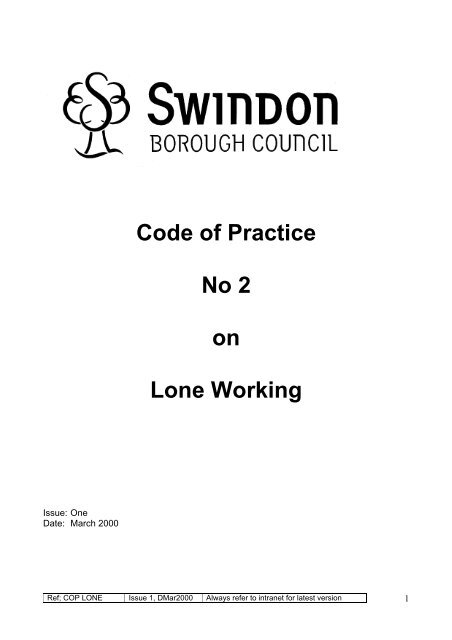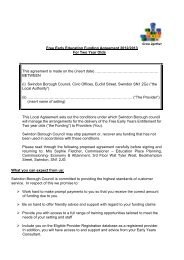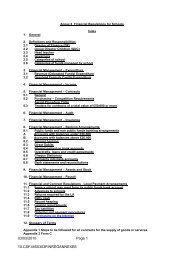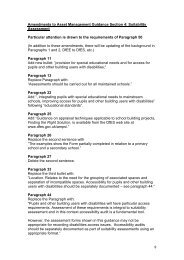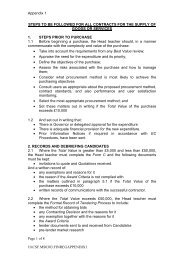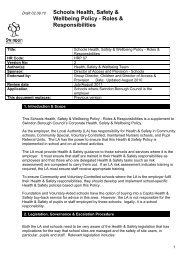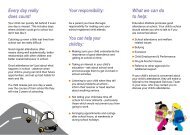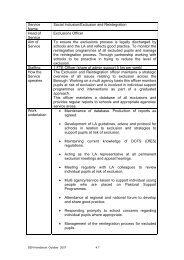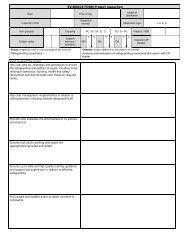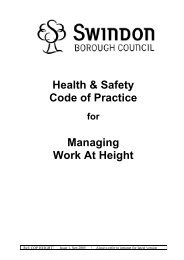Lone Working Policy - SchoolsOnline - Swindon Borough Council
Lone Working Policy - SchoolsOnline - Swindon Borough Council
Lone Working Policy - SchoolsOnline - Swindon Borough Council
You also want an ePaper? Increase the reach of your titles
YUMPU automatically turns print PDFs into web optimized ePapers that Google loves.
Code of PracticeNo 2on<strong>Lone</strong> <strong>Working</strong>Issue: OneDate: March 2000Ref; COP LONE Issue 1, DMar2000 Always refer to intranet for latest version 1
SWINDON BOROUGH COUNCILHEALTH & SAFETY AT WORK<strong>Policy</strong> on <strong>Lone</strong> <strong>Working</strong>Statement of IntentIt is the policy of <strong>Swindon</strong> <strong>Borough</strong> <strong>Council</strong> to ensure that in situations in which membersof staff may be involved in lone working, the <strong>Borough</strong> <strong>Council</strong> will ensure so far as isreasonably practicable, the health, safety and welfare of these staff.Organisation and ArrangementsIn accordance with the <strong>Borough</strong> <strong>Council</strong>'s "Statement of <strong>Policy</strong> on Health & Safety atWork", Directors are responsible for applying the <strong>Council</strong>'s Health and Safety policy withintheir respective Service Areas. In particular, Directors are responsible within theirrespective Service Areas for the provision and maintenance of procedures for dealing withlone working and for carrying out and recording the necessary Risk Assessments.Chief ExecutiveJanuary 2000Ref; COP LONE Issue 1, DMar2000 Always refer to intranet for latest version 2
SWINDON BOROUGH COUNCILCODE OF PRACTICE FOR LONE WORKINGCONTENTSSection:Page No:i) Introduction 4ii) Definition of <strong>Lone</strong> <strong>Working</strong> 41 Visiting Customers & Clients away from the Workplace 52 <strong>Working</strong> Away and Travelling to/from the Workplace 53 Handling of Violent Situations 64 Safe <strong>Working</strong> Arrangements 95 Handling Money 106 Staff Support 117 Training 11Appendices: 1 Managers Toolkit for Staff who Work Alone 13Ref; COP LONE Issue 1, DMar2000 Always refer to intranet for latest version 3
i) INTRODUCTIONIt is the responsibility of managers to ensure the safety of staff working aloneaway from the workplace and travelling to and from the workplace.<strong>Lone</strong> working procedures must be established for staff working alone or away fromthe workplace and travelling to and from the workplace.This Code of Practice provides practical guidance and information to enablemanagers to develop lone working procedures specific to their operationsthrough risk assessment.RISK ASSESSMENT must be undertaken in relation to any LONEWORKING situation - THIS IS THE MANAGER'S RESPONSIBILITY.ii)DEFINITION OF LONE WORKINGThe <strong>Council</strong> has defined lone working as any situation where a member of staff isengaged in a solo activity out of others' sight and hearing range where they maypotentially be exposed to unacceptable risk.Examples of lone working are:- working in a fixed establishment with no other persons on site, or when othersmay be elsewhere on site- working in a remote location including outdoors- work on other employers' premises or working from home- travelling in the course of work.Examples at the <strong>Borough</strong> <strong>Council</strong> are:- Social Workers - Education Welfare Officers - Car Parking Officers- Maintenance Staff - Construction Site Workers - Highway Inspectors- Enforcement Officers - Transport Escorts - Building Surveyors- Building Control Officers - Environmental Health OfficersThe list is not exhaustive.Ref; COP LONE Issue 1, DMar2000 Always refer to intranet for latest version 4
1 VISITING CUSTOMERS & CLIENTS AWAY FROM THE WORKPLACE1.1 Conduct whilst on official <strong>Council</strong> businessThe public is entitled to expect of staff the highest standard of conduct. Thesenotes are guidance for staff who carry out work alone on behalf of the <strong>Council</strong> inoccupied premises, or when work involves contact with the public.1.1.1 Staff are issued with an identity badge and it must be worn at all times in a positionwhere it is easily visible. The exception to this for the lone worker is where thedisplay of the identity badge may provoke an attack.1.1.2 Staff should be helpful at all times and when possible answer any queries raised. Ifsomeone's manner appears aggressive or abusive, staff must avoid arguments orconfrontation. If unable to answer the queries raised or otherwise placate theperson, staff should give them the name and telephone number of the person whomay be able to assist. If, at any time while working alone a situation appears likelyto get out of hand, staff should cease work, leave the place and immediatelyREPORT the matter to their supervisor.1.1.3 Staff visiting occupied premisesThis is an example of a Code of Practice for lone working, similar Codes of Practicemust be developed for specific lone working staff in the directorates across the<strong>Borough</strong> <strong>Council</strong>. The specific need for Codes of Practice and safe systems of workwill be as a direct result of Risk Assessment.If you are required to work alone in occupied premises you must on arrival:-(i)introduce yourself and produce your identity card;(ii) explain the purpose of your visit and give an indication of how longyou expect the work to take;(iii)ask the occupier to inform the other occupants of your presence;(iv) tell the occupier if it is necessary for you to leave the premises; andwhen you will return;(v) on departure make safe the area of work and secure or removeequipment or materials;(vi)inform the occupier when the work is completed.1.2 Practical Issues1.2.1 Service Area records should include a factual statement on any recorded incidentsof violence by customers and clients.1.2.2 If a particularly significant incident occurs or where an escalation of aggressionoccurs within a Service Area, a meeting should be called by the appropriate SeniorRef; COP LONE Issue 1, DMar2000 Always refer to intranet for latest version 5
Officer. Such a meeting should take place as soon as possible and should involveall relevant staff who will review procedures and make recommendations to theirDirector. All staff must be informed of any revisions to procedures.1.2.3 Members of staff must exercise caution and discretion when investigating adisturbance. They are encouraged to involve their manager and/or the Police asappropriate.2 WORKING AWAY & TRAVELLING TO/FROM THE WORKPLACE2.1 Personal Safety2.1.1 Managers must establish a communication system with staff who are working awayfrom the workplace for prolonged periods or visiting a number of different places.For example: radio pagers, or phoning in systems. A centrally based writtenlog/booking board of staff movements must also be maintained.2.1.2 Refer to Section 4 for typical examples of Safe <strong>Working</strong> Arrangements.2.2 Visiting Customers/Clients2.2.1 Managers must check with available records to seek information about customersbefore a visit which has or may have the potential for violence.2.2.2 Managers must structure their operations so that adequate back-up is available andthe responsibility for finding backup must not be left to the individual member ofstaff.2.2.3 Staff must consult with their manager over any arrangements to meet/visit acustomer where there exists, or can be anticipated, an aggressive or violentsituation.2.2.4 Service Areas should share information within and between them when it isbelieved there may be a risk of a violent situation.2.2.5 Staff should leave at any warning signs of danger.3 HANDLING VIOLENT SITUATIONS3.1 The following paragraphs give examples of situations where violence can occur,some warning signs of violence, some DO's and DON'Ts when violence isanticipated and guidance as to the use of physical restraint.3.2 Potentially Violent Situations3.2.1 Personal frustration obviously being felt by a customer.3.2.2 A need to confront or challenge a customer.3.2.3 A need to dominate or win a situation.Ref; COP LONE Issue 1, DMar2000 Always refer to intranet for latest version 6
3.2.4 Exhaustion or stress in staff.3.2.5 Inexperienced staff lacking support and adequate supervision.3.2.6 A lack of information on the background of a customer.3.2.7 A change of routine.3.3 Warning SignsThe following list is of some signs that can precede violence. Staff should learn tobe alert to signs of a build up of tension.3.3.1 Restless behaviour involving pushing and jostling.3.3.2 Deliberately provocative conduct.3.3.3 A customer who is unusually quiet and withdrawn or abnormally loud andboisterous.3.3.4 Over-sensitive reactions.3.3.5 A feeling of tension in an interview.3.3.6 A previous known history of violence.3.3.7 Client under the influence of alcohol, drugs etc.3.3.8 May be tense and agitated.3.3.9 Voice pitch and volume may increase.3.3.10 May reply to questions abruptly very often with gesticulations.3.3.11 Pupils may become dilated.3.3.12 Signs of muscular tension in the face and limbs.3.3.13 Sudden appearance of agitated family, friends, uninvited visitors.3.4 When Violence is anticipated the following is a list of some DO's andDON'Ts3.4.1 DO, if possible, discuss the situation and plan a course of action with your manager,and/or colleague(s).3.4.2 DO ensure that support and/or back up has been organised as appropriate.3.4.3 DO, if possible, prepare customers in advance if you are to be the bearer ofdistressing news. Invite them to the office; or your territory - ensure safety ofothers.Ref; COP LONE Issue 1, DMar2000 Always refer to intranet for latest version 7
3.4.4 DO take off your neck-tie, necklace and other jewellery which could cause injury ifviolence occurs.3.4.5 DO consider sitting down. This is less aggressive, however may leave you morevulnerable, be able to escape quickly.3.4.6 DO try to maintain a relaxed posture.3.4.7 DO stay aware of your own feelings and reactions to those of your customer. Youare then more able to adjust your own responses to reduce the risk of violence.3.4.8 DO listen to a customer's thoughts and feelings and communicate that recognition.3.4.9 DO, if possible, remove yourself and your customer from a group if the group'spresence is exacerbating things. It is harder to back down in front of peers.3.4.10 Do be aware of any drugs (prescribed/illegal), alcohol or solvents which a customermay have taken or be taking.3.4.11 DO consider any previous known confrontations between employees and yourcustomer.3.4.12 DO try to remain reasonable, only attempt to put limits on the customer's behaviourif you think it will be effective.3.4.13 DO remove yourself immediately you feel that a customer is about to attack you.3.4.14 DO call the police as soon as possible if threatened with violence or attack.3.4.15 DO lock doors and windows in buildings and vehicles to prevent an aggressor'saccess to you.3.4.16 DON'T touch a potentially violent person to try to eject them or to prevent damageto property.3.4.17 DON'T move suddenly as sudden movement may alarm the customer.3.4.18 DON'T be physically overbearing.3.4.19 DON'T point at the customer.3.4.20 DON'T put either yourself or the customer in a corner. Make sure that you eachhave exits and that either of you can back down without losing face.3.4.21 DON'T get into a verbal battle or feel or act as if you always have to win a point.3.5 Use of Physical RestraintIn very exceptional circumstances, physical restraint may be necessary. It shouldonly be considered if all other attempts to prevent violence have failed and themember of staff has received appropriate training, and should not be undertaken byRef; COP LONE Issue 1, DMar2000 Always refer to intranet for latest version 8
lone workers. Only minimum and reasonable force may be used in order to restrainand calm a customer.4 SAFE WORKING ARRANGEMENTS4.1 <strong>Lone</strong> workers face particular problems and some of the issues which need specialattention when planning safe working arrangements are as follows:4.2 Can the risks of the job be adequately controlled by one person or are morepeople necessary?4.2.1 <strong>Lone</strong> workers should not be exposed to significantly more risks than staff who worktogether. Precautions should take account of normal working conditions andforeseeable emergency situations e.g. fire, equipment failure, illness and accidents.Identify all places where people work alone and ask:4.2.2 Does the workplace present a special risk to the lone worker?4.2.3 Is there safe access and exit for one person. Can one person safely handle anytemporary access equipment which is necessary such as portable ladders andtrestles?4.2.4 Can all plant, substances and goods involved in the work be safely handled by oneperson? The work may involve lifting objects too large for one person; more thanone person may be necessary to operate essential controls for the safe running ofequipment.4.2.5 Will cash be handled and will there be any risk of violence?4.3 Is the member of staff medically fit and suitable to work alone?4.3.1 Check that the lone workers have no record of medical conditions which make themunsuitable for working alone. Seek medical advice from the <strong>Council</strong>'s MedicalAdvisor. Consider both routine work and foreseeable emergencies which mayimpose additional physical and medical burdens on an individual.4.4 What training is needed to ensure proficiency in safety matters?4.4.1 Training is particularly important where there is limited supervision to control, guideand help in situations of uncertainty. It may be critical to avoid panic reactions inunusual situations. <strong>Lone</strong> workers need to understand fully the risks involved in thework, the necessary precautions and be sufficiently experienced. Service Areasprocedures must set limits to what can and cannot be done while working alone.The Service Area procedures should specify how to behave in circumstances whichare new, unusual or beyond the scope of training - they must state when to stopwork and when to seek advice from their manager.4.5 How will the member of staff be supervised?4.5.1 Although lone workers cannot be under constant supervision, it is still the managersresponsibility to provide appropriate control of the work. Supervision complementsRef; COP LONE Issue 1, DMar2000 Always refer to intranet for latest version 9
information, instruction and training and helps to ensure that staff understand therisks associated with their work and that the necessary safety precautions arecarried out. It can also provide guidance in situations of uncertainty.4.5.2 The extent of supervision required depends on the risks involved and the proficiencyand experience of the member of staff to identify and handle safety issues. Staffnew to the job, undergoing training, doing a job which presents special risks, ordealing with new situations need to be accompanied at first. The extent ofsupervision required is a management decision. It should not be left to individuals todecide they require assistance. Safety supervision can generally be carried outwhen visits are made to check the progress and quality of the work and may takethe form of periodic site visits coupled with discussions in which safety issues areassessed.4.6 What happens if a person becomes ill, has an accident or there is anemergency?4.6.1 <strong>Lone</strong> workers should be capable of responding correctly in emergency situations.Emergency procedures should be established and staff trained to implement them.Information about emergency procedure should be given to solitary contractworkers who visit <strong>Council</strong> premises. <strong>Lone</strong> workers should have access to adequatefirst aid facilities and mobile workers should carry a first aid kit suitable for treatingminor injuries. Emergency Services should be called when significant illness orinjury is suspected.4.6.2 Suitable systems should be devised to monitor the condition of lone workers andinclude at least periodic checks at hourly intervals and a check at the end of theworking period. In addition it is desirable to consider the following:4.6.2.1Establish procedures where managers periodically visit and visually monitor peopleworking alone.4.6.2.2Establish procedures for making regular contact between the lone worker and acolleague is maintained using either telephones or radio.4.6.2.3Automatic warning devices which operate if specific signals are not receivedperiodically from the lone worker are available.4.6.2.4Other devices to raise the alarm in the event of an emergency operated manually oractivated automatically by the absence of activity are available.4.6.2.5Equipment checks on radios and telephones should always be undertaken beforesetting out to work alone.5 HANDLING MONEY5.1 People who collect or carry money as part of their normal work when working aloneare at an increased risk of violence or assault.Ref; COP LONE Issue 1, DMar2000 Always refer to intranet for latest version 10
5.2 Arrangements for the delivery and collection of money will be kept under review bythe Director of Finance and Property.5.3 No member of staff while working alone is required to place themselves 'at risk'when handling money or more particularly when confronted by a potentiallyaggressive or violent situation. If any member of staff is threatened with violencewhilst carrying money and working alone, then the cash should be handed over.Staff should, if possible, try to note the details of their assailant's appearance or anyother useful information (e.g. vehicle registration number), which could be of helplater to the police.5.4 All money collected must be banked in accordance with the <strong>Borough</strong> <strong>Council</strong>'sfinancial regulations. It is the responsibility of managers where appropriate to makesure that staff know about these procedures. If staff are working alone andhandling cash, however small the amount, and are not sure if there is a need to doso, or if there is an acceptable alternative to handling cash, the manager should beconsulted.5.5 The requirement to handle cash while working alone should be an absolute lastresort and management should attempt to prevent this need within their ServiceAreas.6 STAFF SUPPORT6.1 Support6.11 In the event of a violent incident while working alone the relevant senior managershould offer as much support as possible.6.1.2 Staff who suffer trauma due to violent incidents while working alone will, if they wishreceive the immediate services of the <strong>Council</strong>'s Staff Support Service at BelgraveHouse, 77 High Street, Wroughton. Tel 815279.6.1.3 Further detailed information regarding support for staff is contained in Code ofPractice No. 3 - Violence and Aggression.7 TRAINING7.1 All staff who are likely to be involved in working alone in circumstances related totheir employment will be given either on or off-the-job training in the following areas:7.1.1 Raising awareness of lone working.7.1.2 Raising awareness of potentially violent situations.7.1.3 How best to diffuse potentially violent situations.7.1.4 Raising awareness of physical aggression.Ref; COP LONE Issue 1, DMar2000 Always refer to intranet for latest version 11
7.1.5 How to protect yourself from physical injury when diffusion techniques have beenattempted/used and violence still occurs.7.1.6 Raising awareness of personal safety going to and coming from the workplace.7.1.7 Procedures associated with communications and the use of alarms.7.2 The intention is to provide awareness training in working alone and the handling ofviolent or potentially violent situations for all those staff who are likely to come intocontact with them. Priority for off-the-job training will be given to staff in identifiedsensitive areas.Ref; COP LONE Issue 1, DMar2000 Always refer to intranet for latest version 12
APPENDIX 1RISK ASSESSMENT IS REQUIRED FOR LONE WORKINGManagers Toolkit for Staff who Work AloneThe following is a toolkit of control measures and working methods that ServiceAreas can utilise when establishing their lone working procedures. <strong>Lone</strong> workingprocedures should be developed based on risk assessment:1 Toolkit items for normal hours lone working.Learn from experience.Know where you are going and who you might meet.Read any project file and obtain relevant information about persons and property.Consult health and safety records with reference to any known lone working safetyissuesConsult other Service Areas with regard lone working safety issues.Consult <strong>Council</strong>'s Intranet reference any security issues.Wear your SBC Identity Badge where appropriate.Supervisors/Managers must be made aware of where staff are going and what timestaff intend to return to their usual place of work.Utilise an Office Diary System.Utilise a Booking Out Board System.Carry a mobile phone, either personal or from a pool - record phone number on anymanagement system used and keep it switched on throughout period of loneworking.Carry a radio and contact the <strong>Council</strong>'s Control Room at regular intervals.Carry a Radio Pager.Regularly call in to the Control Room or a Supervisor/Manager especially duringlong periods of absence from the office.Tell your manager if you are not returning to the office and book off the lone workingperiod via a phone or radio call with the time of finishing work.Obtain information on any premise where an incident has been reported previouslyby any Service Area alone - go with a support member of staff.Ref; COP LONE Issue 1, DMar2000 Always refer to intranet for latest version 13
Avoid lone working if practicable after 3pm.Carry Dog Dazers if concerned about attack from dogs.Carry personal attack alarms if considered appropriate.Avoid carrying handbaggage.Conceal all valuables, avoid carrying if possible.Avoid working alone in adverse weather conditions.Ensure regular changes in working routine.Consider where you park your car in relation to your destination.Ensure appropriate attire including personal protective equipment is worn whereapplicable e.g. reflective coats.Where there is a perceived high risk to personal safety working in pairs isrecommended.Plan your route.Leave at any warning signs of danger.Panic buttons in office areas.Train staff.Regular staff briefings and review.Communicate any changes in information.Communicate new information.Disseminate to all staff procedures and policies.Emergency response teams.2 Additional toolkit items for out of normal hours lone working.As well as 1.Log time of departure, time of visit start, time of visit anticipated finish with SBCcontrol room - ensure contact mobile no is with them so that they can call you andraise any alarm - emergency contacts should also be given to Control for contact.If during darkness - know where you are going and how to get there.If during darkness - always carry a torch.Ref; COP LONE Issue 1, DMar2000 Always refer to intranet for latest version 14
If during darkness - walk briskly do not waste any time.If during darkness - if while walking you perceive you are being followed cross andre-cross the road, make your way to a busy area, walk briskly raise the alarm viayour phone or radio.If during darkness - park in a well lit area, when walking keep to well lit streets andface oncoming traffic.Operate a remote Personal Safety Monitoring System e.g. INFORM.Note: THIS LIST IS NOT EXHAUSTIVE.UTILISE FOR RISK ASSESSMENTRef; COP LONE Issue 1, DMar2000 Always refer to intranet for latest version 15


